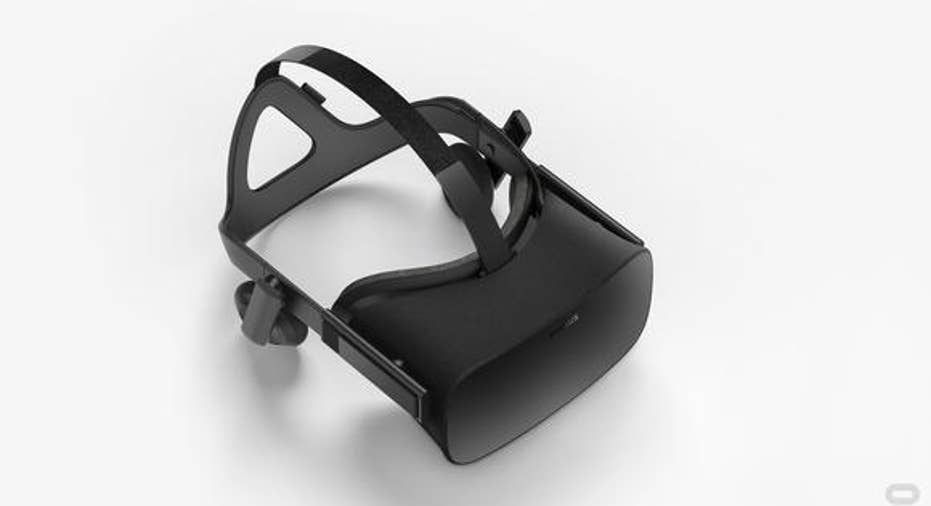The Oculus Rift Is Good News for NVIDIA and AMD

There are already various virtual-reality headsets on the market, including the Gear VR from Samsung and Google Cardboard, both of which work by inserting a smartphone into the device. These early VR headsets are inexpensive, but they're ultimately limited by the power available in a high-end smartphone.
The Oculus Rift, a VR headset designed by Oculus VR, now a subsidiary of Facebook, is set to launch during the first quarter of 2016, bringing with it a far more powerful version of VR. The Rift will need to be tethered to a high-end PC to function, meaning that the potential market for the first-generation version of the device will be limited to those with $1,000 PCs.
The Oculus Rift. Source: Oculus VR.
Two obvious beneficiaries of VR are NVIDIA and Advanced Micro Devices , both of which design the graphics processors that go into PCs. The Oculus Rift requires a PC with at least a GTX 970 from NVIDIA or a Radeon 290 from AMD, graphics cards that retail for between $250 and $300. If the launch of the Rift drives PC gamers to upgrade to beefier graphics cards, both NVIDIA and AMD could see a boost in sales.
The unique requirements of VRThe Oculus Rift will have dual displays, one for each eye, with a total resolution of 2160x1200 and a refresh rate of 90Hz. The PC connected to the Rift will need to process about 233 million pixels per second, nearly twice the rate of a common gaming PC setup consisting of a 1920x1080 screen with a 60Hz refresh rate. It's no wonder, then, that a powerful graphics card will be required.
The Rift has another requirement: The rate that the connected PC produces frames should always be at or above the refresh rate of the Rift's displays. If the PC can't keep up, the result will be dropped frames and juddering. This isn't a big deal on a normal PC monitor, but for someone wearing the Rift headset, juddering breaks the immersion and could result in discomfort or motion sickness. For this reason, lower-end graphics cards won't cut it.
Because of the high cost of a Rift-compatible PC, not to mention the price tag of the headset itself, which will cost "more than $350," according to Oculus VR founder Palmer Luckey, it seems likely that early adopters will be those who already have powerful gaming PCs.
In other words, the number of graphics cards sold probably isn't going to increase dramatically because of the launch of the Rift. However, depending on how popular the Rift becomes, PC gamers who typically buy lower-end graphics cards may be enticed to upgrade to a higher-end product. For NVIDIA, high-end graphics cards carry gross margins in the 60%-65% range, compared with around 55% for the company as a whole, so a shift toward the high end could boost profitability.
The importance of softwareHigh-end graphics cards from both NVIDIA and AMD can handle the requirements of the Rift, but software may be what sets the two companies apart. Last year, NVIDIA launched GameWorks, a suite of tools, code libraries, and APIs aimed at game developers, and the company has been adding new functionality ever since. GameWorks allows developers to implement complex features, such as realistic shadows and hair, without having to build a system from the ground up. Naturally, GameWorks is optimized to work best on NVIDIA hardware.
GameWorks now includes the GameWorks VR software development kit, allowing developers to take full advantage of NVIDIA's hardware for VR applications. AMD has released something similar, LiquidVR, but the company offers no alternative to the full GameWorks suite. GameWorks has been used in a significant number of high-profile games, including Assassin's Creed Syndicate and Grand Theft Auto V, as well as popular game engines like Unreal Engine 4.
With NVIDIA claiming an 81% unit share of the discrete graphics card market during the third quarter, it shouldn't be surprising that many developers have integrated various GameWorks features into their games. AMD has been struggling in general, posting losses in each of the last four quarters as its market shares in both graphics cards and CPUs have collapsed, and a lack of resources will make it difficult for the company to catch up to NVIDIA when it comes to software.
The Oculus Rift has the potential to drive demand for high-end GPUs, and while both NVIDIA and AMD stand to benefit, NVIDIA appears to be in a stronger position. NVIDIA's market share dominance and its advantage in providing developers with software should give the company an edge in the VR battle to come.
The article The Oculus Rift Is Good News for NVIDIA and AMD originally appeared on Fool.com.
Timothy Green owns shares of Nvidia. The Motley Fool owns shares of and recommends Alphabet (A shares), Alphabet (C shares), and Facebook. The Motley Fool recommends Nvidia. Try any of our Foolish newsletter services free for 30 days. We Fools may not all hold the same opinions, but we all believe that considering a diverse range of insights makes us better investors. The Motley Fool has a disclosure policy.
Copyright 1995 - 2015 The Motley Fool, LLC. All rights reserved. The Motley Fool has a disclosure policy.



















